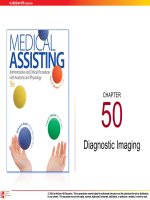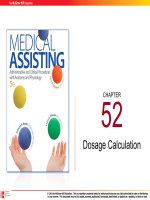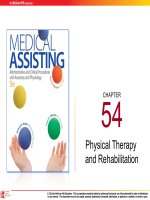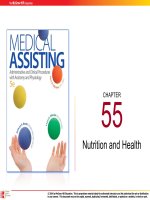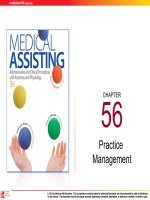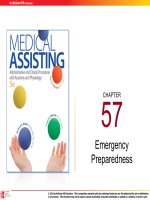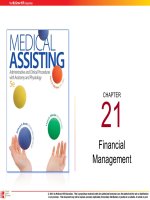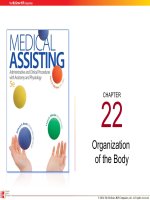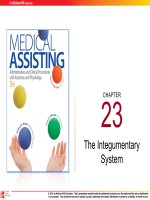Medical assisting Administrative and clinical procedures (5e) Chapter 54 Physical therapy and rehabilitation
Bạn đang xem bản rút gọn của tài liệu. Xem và tải ngay bản đầy đủ của tài liệu tại đây (1.22 MB, 58 trang )
CHAPTER
54
Physical Therapy
and Rehabilitation
© 2014 by McGraw-Hill Education. This is proprietary material solely for authorized instructor use. Not authorized for sale or distribution
in any manner. This document may not be copied, scanned, duplicated, forwarded, distributed, or posted on a website, in whole or part.
54-2
Learning Outcomes
54.1 Discuss the general principles of physical
therapy.
54.2 Relate various cold and heat therapies to
their benefits and contraindications.
54.3 Recall hydrotherapy methods.
54.4 Name several methods of exercise therapy.
© 2014 by McGraw-Hill Education. This is proprietary material solely for authorized instructor use. Not authorized for sale or distribution
in any manner. This document may not be copied, scanned, duplicated, forwarded, distributed, or posted on a website, in whole or part.
54-3
Learning Outcomes
54.5 Describe the types of massage used in
rehabilitation therapy.
54.6 Compare different methods of traction.
54.7 Carry out the procedure for teaching a
patient to use a cane, a walker, crutches,
a wheelchair.
and
54.8 Model the steps you should take when
referring a patient to a physical therapist.
© 2014 by McGraw-Hill Education. This is proprietary material solely for authorized instructor use. Not authorized for sale or distribution
in any manner. This document may not be copied, scanned, duplicated, forwarded, distributed, or posted on a website, in whole or part.
54-4
Introduction
• Medical assistant
– Apply cold and heat
– Assist with ambulation
– Teach basic exercises
– Demonstrate how to use a cane, walker,
crutches, or wheelchair
– Discuss with the patient specific therapies for
home use
© 2014 by McGraw-Hill Education. This is proprietary material solely for authorized instructor use. Not authorized for sale or distribution
in any manner. This document may not be copied, scanned, duplicated, forwarded, distributed, or posted on a website, in whole or part.
54-5
General Principles of Physical Therapy
• Physical therapy
– Medical specialty treating
• Musculoskeletal disorders
• Nervous disorders
• Cardiopulmonary disorders
– Treatments
– Patient benefits
– Disorders
© 2014 by McGraw-Hill Education. This is proprietary material solely for authorized instructor use. Not authorized for sale or distribution
in any manner. This document may not be copied, scanned, duplicated, forwarded, distributed, or posted on a website, in whole or part.
54-6
Assisting Within a Therapeutic Team
• Therapeutic team members
• Medical assistant
– Coordinate the patient’s schedule
– Make referrals
– Document treatments and findings
– Reinforce instructions for the patient
– Answer the patient’s questions
© 2014 by McGraw-Hill Education. This is proprietary material solely for authorized instructor use. Not authorized for sale or distribution
in any manner. This document may not be copied, scanned, duplicated, forwarded, distributed, or posted on a website, in whole or part.
54-7
Assisting with Patient Assessment
• Joint mobility testing
– Range of motion (ROM) – degree to which
a joint is able to move
– Goniometer
– Degree of movement
compared to a standard
© 2014 by McGraw-Hill Education. This is proprietary material solely for authorized instructor use. Not authorized for sale or distribution
in any manner. This document may not be copied, scanned, duplicated, forwarded, distributed, or posted on a website, in whole or part.
54-8
Assisting with Patient Assessment (cont.)
• Muscle strength testing
– Determines the amount of force exerted
exert with a group of muscles
– Compare each side of body
• Gait testing –
assessment of how
a patient walks
© 2014 by McGraw-Hill Education. This is proprietary material solely for authorized instructor use. Not authorized for sale or distribution
in any manner. This document may not be copied, scanned, duplicated, forwarded, distributed, or posted on a website, in whole or part.
54-9
Assisting with Patient Assessment (cont.)
• Posture testing
– Body position and alignment
– Checks spinal curves
– Symmetry of alignment
© 2014 by McGraw-Hill Education. This is proprietary material solely for authorized instructor use. Not authorized for sale or distribution
in any manner. This document may not be copied, scanned, duplicated, forwarded, distributed, or posted on a website, in whole or part.
54-10
Apply Your Knowledge
Match description with assessment type:
ANSWER:
___
D How a person walks
A. Joint mobility
A Range of motion
___
B. Muscle strength
C Body position and alignment
___
C. Posture
B Force exerted with a group of muscles D. Gait
___
A Goniometer
___
C Check spinal curves
___
D Length of stride
___
© 2014 by McGraw-Hill Education. This is proprietary material solely for authorized instructor use. Not authorized for sale or distribution
in any manner. This document may not be copied, scanned, duplicated, forwarded, distributed, or posted on a website, in whole or part.
54-11
Cryotherapy and Thermotherapy
• Cryotherapy
• Thermotherapy
– Applying cold for
therapeutic
reasons
– Applying heat for
therapeutic
reasons
– Types
– Types
• Wet or dry
• Dry
• Chemical or natural
• Moist
© 2014 by McGraw-Hill Education. This is proprietary material solely for authorized instructor use. Not authorized for sale or distribution
in any manner. This document may not be copied, scanned, duplicated, forwarded, distributed, or posted on a website, in whole or part.
54-12
Cryotherapy and Thermotherapy (cont.)
• Factors affecting use
– Therapy's purpose
– Location and condition of affected area
– Patient’s age and general health
• Monitor patient for signs of tissue damage
• Be aware of
contraindications
© 2014 by McGraw-Hill Education. This is proprietary material solely for authorized instructor use. Not authorized for sale or distribution
in any manner. This document may not be copied, scanned, duplicated, forwarded, distributed, or posted on a website, in whole or part.
54-13
Cryotherapy and Thermotherapy (cont.)
• Treatment location
• Circulation or sensation impairment
• Temperature tolerance
• Elderly’s sensitivity to cold and heat
© 2014 by McGraw-Hill Education. This is proprietary material solely for authorized instructor use. Not authorized for sale or distribution
in any manner. This document may not be copied, scanned, duplicated, forwarded, distributed, or posted on a website, in whole or part.
54-14
Principles of Cryotherapy
• Constricts blood vessels
• Physiologic responses to cold
– Prevents swelling
– Anesthetic effect
– Controls bleeding
– Reduces pus
formation
– Reduces
inflammation
– Lowers body
temperature
© 2014 by McGraw-Hill Education. This is proprietary material solely for authorized instructor use. Not authorized for sale or distribution
in any manner. This document may not be copied, scanned, duplicated, forwarded, distributed, or posted on a website, in whole or part.
54-15
Administering Cryotherapy
• Dry cold applications
– Ice bags and collars
– Chemical ice packs
• Wet cold applications
– Cold compresses
– Ice massage
© 2014 by McGraw-Hill Education. This is proprietary material solely for authorized instructor use. Not authorized for sale or distribution
in any manner. This document may not be copied, scanned, duplicated, forwarded, distributed, or posted on a website, in whole or part.
54-16
Principles of Thermotherapy
• Dilates blood vessels – erythema
• Physiologic responses to heat
– Relieves pain and congestion
– Reduces muscle spasms
– Relaxes muscles
– Reduces inflammation and
swelling
© 2014 by McGraw-Hill Education. This is proprietary material solely for authorized instructor use. Not authorized for sale or distribution
in any manner. This document may not be copied, scanned, duplicated, forwarded, distributed, or posted on a website, in whole or part.
54-17
Administering Thermotherapy
• Dry heat therapies
– Chemical hot
packs
– Heating pad
– Hot-water bottle
– Heat lamp
– Fluidotherapy
© 2014 by McGraw-Hill Education. This is proprietary material solely for authorized instructor use. Not authorized for sale or distribution
in any manner. This document may not be copied, scanned, duplicated, forwarded, distributed, or posted on a website, in whole or part.
54-18
Administering Thermotherapy (cont.)
• Moist heat applications
– Hot soak
– Paraffin bath
– Hot compress
– Alternating hot
and cold packs
– Hot pack
© 2014 by McGraw-Hill Education. This is proprietary material solely for authorized instructor use. Not authorized for sale or distribution
in any manner. This document may not be copied, scanned, duplicated, forwarded, distributed, or posted on a website, in whole or part.
54-19
Administering Thermotherapy (cont.)
• Diathermy
– High-frequency wave achieves deep heat
penetration
– Types
• Ultrasound
• Shortwave
• Microwave
© 2014 by McGraw-Hill Education. This is proprietary material solely for authorized instructor use. Not authorized for sale or distribution
in any manner. This document may not be copied, scanned, duplicated, forwarded, distributed, or posted on a website, in whole or part.
54-20
Apply Your Knowledge
What is the main difference in the effect of
cryotherapy and thermotherapy that results in the
physiologic response of each?
ANSWER: Cryotherapy causes blood vessels to
constrict, resulting in its physiologic effects, while
thermotherapy causes blood vessels to dilate.
© 2014 by McGraw-Hill Education. This is proprietary material solely for authorized instructor use. Not authorized for sale or distribution
in any manner. This document may not be copied, scanned, duplicated, forwarded, distributed, or posted on a website, in whole or part.
54-21
Hydrotherapy
• Use of water to treat physical
problems
• Whirlpools
– Water is agitated by jets of air under pressure
– Generates hydromassage
• Relaxes muscles
• Increases circulation
© 2014 by McGraw-Hill Education. This is proprietary material solely for authorized instructor use. Not authorized for sale or distribution
in any manner. This document may not be copied, scanned, duplicated, forwarded, distributed, or posted on a website, in whole or part.
54-22
Hydrotherapy (cont.)
• Contrast baths
– 2 baths, one hot
and one cold
– Affected area is
quickly moved
from one to the
other
• Underwater
exercises
– Warm swimming
pool
– Buoyancy takes
pressure off joints
© 2014 by McGraw-Hill Education. This is proprietary material solely for authorized instructor use. Not authorized for sale or distribution
in any manner. This document may not be copied, scanned, duplicated, forwarded, distributed, or posted on a website, in whole or part.
54-23
Apply Your Knowledge
What are the main effects of hydrotherapy?
ANSWER: Hydrotherapy relaxes muscles,
increases circulation, and improves
flexibility and mobility.
© 2014 by McGraw-Hill Education. This is proprietary material solely for authorized instructor use. Not authorized for sale or distribution
in any manner. This document may not be copied, scanned, duplicated, forwarded, distributed, or posted on a website, in whole or part.
54-24
Exercise Therapy
• Preventive and therapeutic benefits
– Flexibility
– Mobility
– Muscle tone
– Strength
• Primary treatment for some
disorders and sports injuries
© 2014 by McGraw-Hill Education. This is proprietary material solely for authorized instructor use. Not authorized for sale or distribution
in any manner. This document may not be copied, scanned, duplicated, forwarded, distributed, or posted on a website, in whole or part.
54-25
Exercise Therapy (cont.)
• Exercise benefits include
– Improve muscle tone and strength
– Regain or maintain ROM
– Promotes neuromuscular coordination
– Helps patients to resume normal activities of
daily living
© 2014 by McGraw-Hill Education. This is proprietary material solely for authorized instructor use. Not authorized for sale or distribution
in any manner. This document may not be copied, scanned, duplicated, forwarded, distributed, or posted on a website, in whole or part.
